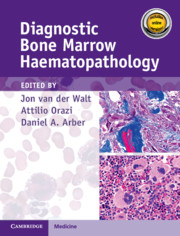Book contents
- Diagnostic Bone Marrow Haematopathology
- Diagnostic Bone Marrow Haematopathology
- Copyright page
- Contents
- Contributors
- Preface
- Acknowledgements
- Chapter 1 The Bone Marrow Biopsy
- Chapter 2 The Normal Bone Marrow
- Chapter 3 Necrosis, Stromal Changes and Artefacts
- Chapter 4 Aplasia
- Chapter 5 Hyperplasia
- Chapter 6 Infective, Granulomatous and Benign Histiocytic Disorders
- Chapter 7 Malignant Disorders of the Histiocytic/Dendritic Lineage
- Chapter 8 Myelodysplastic Syndromes
- Chapter 9 Acute Myeloid Leukaemia
- Chapter 10 Myeloproliferative Neoplasms
- Chapter 11 Myelodysplastic/Myeloproliferative Neoplasms
- Chapter 12 Systemic Mastocytosis
- Chapter 13 Myeloid and Lymphoid Neoplasms Associated with Eosinophilia
- Chapter 14 Precursor Lymphoid Neoplasms
- Chapter 15 Mature Lymphoid Neoplasms
- Chapter 16 Plasma Cell Neoplasia
- Chapter 17 Metastatic Lesions
- Chapter 18 Bone Marrow Changes Following Therapy and Immunosuppression
- Chapter 19 Immunohistochemistry and Flow Cytometry in Bone Marrow Haematopathology
- Chapter 20 Molecular Diagnostics in Bone Marrow Haematopathology
- Index
- References
Chapter 4 - Aplasia
Published online by Cambridge University Press: 12 November 2020
- Diagnostic Bone Marrow Haematopathology
- Diagnostic Bone Marrow Haematopathology
- Copyright page
- Contents
- Contributors
- Preface
- Acknowledgements
- Chapter 1 The Bone Marrow Biopsy
- Chapter 2 The Normal Bone Marrow
- Chapter 3 Necrosis, Stromal Changes and Artefacts
- Chapter 4 Aplasia
- Chapter 5 Hyperplasia
- Chapter 6 Infective, Granulomatous and Benign Histiocytic Disorders
- Chapter 7 Malignant Disorders of the Histiocytic/Dendritic Lineage
- Chapter 8 Myelodysplastic Syndromes
- Chapter 9 Acute Myeloid Leukaemia
- Chapter 10 Myeloproliferative Neoplasms
- Chapter 11 Myelodysplastic/Myeloproliferative Neoplasms
- Chapter 12 Systemic Mastocytosis
- Chapter 13 Myeloid and Lymphoid Neoplasms Associated with Eosinophilia
- Chapter 14 Precursor Lymphoid Neoplasms
- Chapter 15 Mature Lymphoid Neoplasms
- Chapter 16 Plasma Cell Neoplasia
- Chapter 17 Metastatic Lesions
- Chapter 18 Bone Marrow Changes Following Therapy and Immunosuppression
- Chapter 19 Immunohistochemistry and Flow Cytometry in Bone Marrow Haematopathology
- Chapter 20 Molecular Diagnostics in Bone Marrow Haematopathology
- Index
- References
Summary
Aplasia is a pathologic term that is broadly defined as the absence or near-absence of one or more haematopoietic lineages in the bone marrow (BM). Clinically, BM aplasia affecting more than one lineage is referred to as aplastic anaemia (AA), despite the fact that this group of disorders often results in pancytopaenia rather than anaemia alone. Cytopaenias can be seen in a number of different conditions, and new-onset pancytopaenia in children and adults requires an extensive work-up, including a BM core biopsy (BMB) for confirmation of haematopoietic aplasia/hypoplasia and exclusion of an infiltrative marrow process or fibrosis. Bone marrow aplasia develops as a result of injury to multipotent haematopoietic stem cells, which can occur in the context of constitutional (primary aplasia) or acquired (secondary aplasia) disorders (Table 4.1). This chapter will discuss the diagnostic criteria and pathophysiology of specific disorders presenting with aplasia and demonstrate an algorithmic approach to the diagnostic evaluation of patients presenting with this common and non-specific finding (Table 4.2).
- Type
- Chapter
- Information
- Diagnostic Bone Marrow Haematopathology , pp. 42 - 63Publisher: Cambridge University PressPrint publication year: 2021



